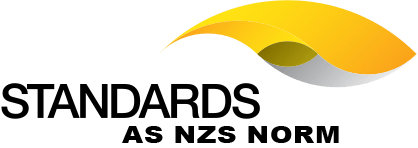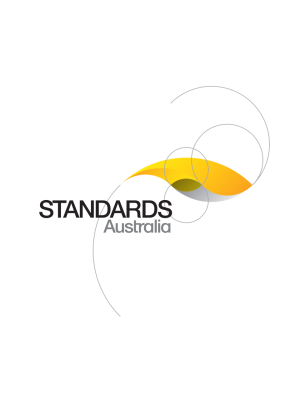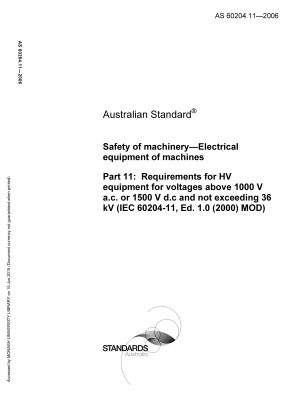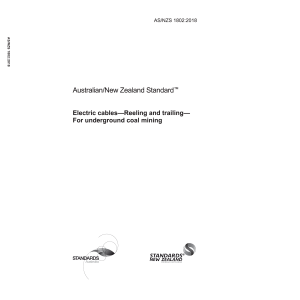🔍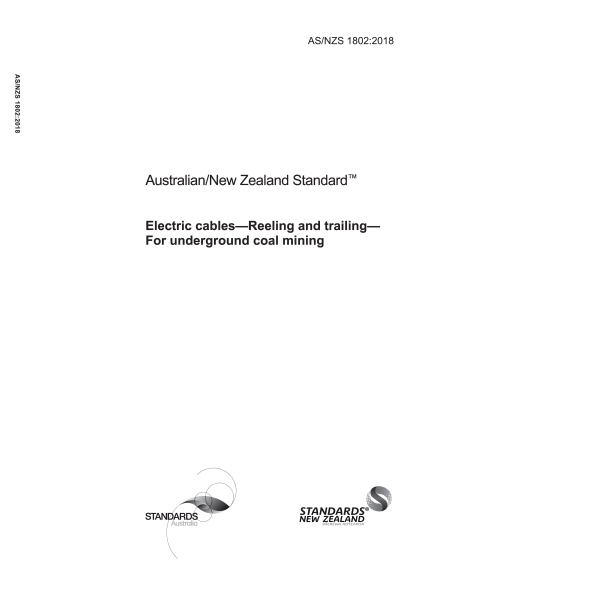

Purchase the full subscription package now and enjoy a 40% discount, along with free updates for future editions.
AS/NZS 1802:2018
$177.61
Electric cables — Reeling and trailing — For underground coal mining
This Standard specifies the application, materials, construction, dimensions and tests for elastomer insulated and sheathed reeling and trailing electric cables, for use in underground coal mines.
Table of contents
Header
About this publication
Preface
1 Scope
2 Referenced documents
3 Definitions
4 Voltage designation
5 Designation and application
6 Maximum conductor temperatures
7 Power, earth and pilot conductors (other than central pilot/control cores and composite earth screens)
7.1 General
7.2 Joints
7.3 Direction of lay
7.4 Length of lay of bunches for interstitial conductors (Types 240, 241, 245, 260, 275 and 280B only)
7.5 Resistance of earth and interstitial pilot conductors
8 Central pilot/control cores (Types 209, 210, 241, 245, 275 and 280B only)
8.1 Conductor material and resistance
8.2 Extensibility of pilot conductor
8.3 Central pilot/control cores (Type 245)
8.4 Joints in central pilot/control conductor
8.5 Material and thickness of insulation
8.6 Location
9 Conductor screen
9.1 General
9.2 Material
9.3 Application
9.3.1 Extruded screen
9.3.2 Taped screen
9.3.3 Combined taped and extruded screen
9.4 Removal from conductor
9.5 Thickness
9.5.1 Extruded screen or combined taped and extruded screen
9.5.2 Taped screen
9.6 Tests
10 Insulation on conductors (other than earth conductors)
10.1 Material
10.2 Application
10.3 Thickness
10.4 Tests
11 Tape over insulation other than semi-conductive tape (Types 209, 210, 240 and 260 only)
11.1 Material
11.2 Application
12 Screens
12.1 General
12.2 Semiconductive elastomer insulation stress relief screen
12.2.1 Material
12.2.2 Application
12.2.3 Thickness of semiconductive screen
12.2.4 Requirements for stripping of screen
12.2.5 Tests
12.3 Semiconductive elastomer insulation earth screen
12.3.1 Material
12.3.2 Application
12.3.3 Thickness of semiconductive screen
12.3.4 Requirements for stripping of screen
12.3.5 Tests
12.4 Textile reinforced semiconductive tape screen (Types 209, 240 and 260 only)
12.4.1 Material
12.4.2 Application
12.5 Textile reinforced semiconductive tape screen (Type 280B only)
12.5.1 Material
12.5.2 Application
12.6 Composite screen (Types 209, 210, 240 and 260 only)
12.6.1 Construction
12.6.2 Joints
12.6.3 Length of lay
12.6.4 Coverage
12.6.5 Resistance
13 Identification of cores
13.1 General
13.2 Identification method
13.3 Identification and rotational sequence
13.3.1 Identification by colours
13.3.2 Identification by numbers
14 Cradle separators
14.1 Material
14.2 Freedom to move and provision for cradle separator fingers
15 Semiconductive elastomer covering for interstitial earth conductors (Types 241, 245, 275 and 280B only)
15.1 Material
15.2 Application
15.3 Thickness
16 Laying up of cores
17 Semiconductive elastomer screen for core assembly (Types 241, 245, 275 and 280B only)
17.1 Material
17.2 Application
17.3 Thickness
18 Reinforcement for core assembly (Types 241, 245, 275 and 280B only)
19 Inner sheath (Type 260 only)
19.1 Material
19.2 Application
19.3 Thickness
19.4 Tests
20 Pliable armour (Type 260 only)
20.1 Material
20.2 Application
21 Outer sheath (all cables)
21.1 Material
21.2 Colour
21.3 Application
21.4 Thickness
21.5 Tests
22 Optional outer sheath reinforcement (Types 209, 240 and 260 only)
22.1 Material
22.2 Location of reinforcement
23 Construction and dimensions (all cables)
24 Joints in completed cable lengths
25 Tests
25.1 Testing—General requirements
25.2 Thickness of insulation, covering and sheath
25.3 High voltage a.c. test for 5 minutes on power cores and pilot conductors
25.4 Electrical conductivity tests on semiconductive components
25.4.1 General
25.4.2 Test voltage and circuit to verify 500 mA immediate minimum current flow
25.4.3 Requirements for all cable types with a semiconductive cradle
25.4.4 Requirements for Types 241, 245, 275 and 280B cable
25.4.5 Requirements for Types 241, 245
25.4.6 Test voltage and circuit to verify the capability to maintain a current flow
25.4.7 Requirement for all cables with a semiconductive cradle
25.4.8 Requirement for Types 241, 245, 275, and 280B
25.4.9 Requirement for Types 241, 245
26 Marking (all cables)
26.1 Internal
26.2 External
26.3 Marking of cable drums
27 Figures of construction and tables of dimensions
Appendix A
A1 General
A2 Information to be supplied by the purchaser
Appendix B
B1 General
B2 Method
B2.1 Outer sheath
B2.1.1 General
B2.1.2 For other than Type 210 up to and including 4 mm2 conductor
B2.1.3 For Type 210 up to and including 4 mm2 conductor
B2.2 Inner sheath and armour (Type 260 only)
Appendix C
C1 Scope
C2 Procedure
C3 Calculation
Cited references in this standard
Please select a variation to view its description.
| Published | 09/05/2018 |
|---|---|
| Pages | 48 |
Please select a variation to view its pdf.
